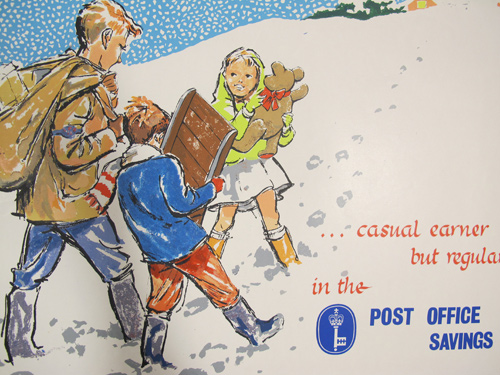How many words do they say the Inuit have for ‘snow’? Four hundred?[ref] 1. As with all delightfully simplistic and faintly derogatory claims, this is indeed a myth: www.uaf.edu/anlc/snow/. [/ref] English seems to have far fewer: snow, disruption, carnage. For while safety concerns rightfully grounded aircraft (and even closed archives) last week, the disruption seemed significant. I wondered what kind of considerations lead to such decisions being made. Surely airlines wouldn’t cancel flights and train operators wouldn’t decide to run reduced services – and suffer decreased revenue as a consequence – without sound reasons? Surely every possible technological consideration would be made to keep services running?

'Casual earner but regular saver', Post Office savings campaign poster, 1963 (NSC 25/385)
The winter of 1962-63 (the so-called ‘Big Freeze’) was bitter, long, and exceptionally cold. Snow covered almost the entire country and there was snowfall each month between November and April. Disruption was significant, as schools struggled to open, roads were blocked, and sporting events cancelled (one football match was cancelled 33 times, and Barnsley, Yorkshire played only twice between late December and mid-March).[ref] 2. www.guardian.co.uk/football/2010/jan/10/fa-cup-1963-freeze-abandonments. [/ref]
Through files held here at The National Archives we can see how closely government monitored technical operations at that time, and stipulated what constituted safe travel. A circular from the Ministry of Aviation sent in September 1962 (found in Board of Trade records – BT 248/355) demonstrates this, as government scientists specified the acceptable levels of slush/water for take-off, as research showed they negatively affect performance and damage aircraft.
The recommendation – ‘…that take-offs, with depths of slush or water on the runway greater than 0.5” (15mm) should not be attempted…’ – was the result of extensive research in the RAF, the Ministry of Aviation, and the Department of Scientific and Industrial Research but further recommendations (take-offs in dry snow should not be attempted when depths exceed 3”) were sometimes more difficult to explain. The Ministry of Aviation circular continues:
‘The forgoing applies to very dry snow, whereas wet snow should normally be treated as if it were slush. It is not easy to provide precise and reliable guidance on differentiating between degrees of wetness of snow…In the absence of satisfactory guidance on the point, snow that is at all wet should be treated as though the full depth were slush.’
At the end of the long winter a report by another Ministry of Aviation official (DSIR 23/30431) explained how London (Heathrow) Airport intended to improve its snow contingencies and keep the airport running as usual (7 million passengers a year, 250 aircraft a day – under the flight path here in Kew, it seems those numbers might have risen in the intervening half century). Through improved planning, and the availability of maintenance staff, expert advice from meteorological staff, and improved equipment (including modified trucks, with RAF ploughs fitted to the front) Heathrow should remain fully operational in future harsh winters. The fact that aircraft should not take-off when slush is more than half an inch deep is also mentioned.
I find the direct influence government has on such decision-making quite fascinating. In the post-nationalisation years since the Thatcher era such influence has surely been diminished, and if files on airport operations in adverse winter weather are released in twenty years, it would be interesting to see who make decisions on airport operations and aircraft safety, and on what basis.
Further information
My colleague Linda kindly pointed me to some further resources, which could be of interest:
Official Committee on Emergencies (The British Winter): minutes of meetings, reports on effect of 1962/63 winter on motorways and trunk roads, Ministry of Transport – MT 133/30.
Art purchased by the government in 1963 – Winter, Dalmeny by John Houston; Skating in Hyde Park by Philip James de Loutherbourg. These purchases, alongside the campaign poster image above (NSC 25/385) perhaps indicates how much the harsh winter imprinted on people’s lives.
That certainly was some winter. One of my main memories was of my cousin looking enviously out of the window at the rest of us playing in the snow, but his mother wouldn’t let him join in because the depth of the snow was higher than the tops of his wellies. Once the show and ice had cleared (eventually) the first thing I noticed was how the previously flat pavements were now full of broken and tilted paving stones, making them much harder to negotiate on my little Mobo scooter.
I searched in Discovery and found a file on ‘Damage to hedges and buildings due to snow clearing operations: policy’ MT 109/332 1963-1964
Thank Audrey, there is undoubtedly plenty of research that could be made into government goings-on during the Big Freeze. This is all augmented by (or perhaps augments) people’s memories of the long winter.
I’d love to hear more from any other readers who remember 1962-63.
Thanks,
Simon